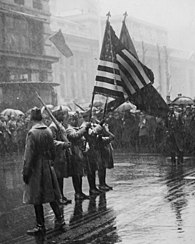Effects of the storage conditions on the stability of natural and synthetic cannabis in biological matrices for forensic toxicology analysis: An update from the literature
Contents
George Ritter Burnett | |
|---|---|
 | |
| Born | April 23, 1858 Lower Providence Township, Pennsylvania |
| Died | November 1, 1908 (aged 50) Lincoln, Nebraska |
| Place of burial | |
| Allegiance | United States of America |
| Service | United States Army Iowa National Guard Missouri National Guard |
| Years of service | 1880–1891 (Army) 1892–1908 (National Guard) |
| Rank | First Lieutenant (Army) Colonel (National Guard) |
| Battles / wars | Indian Wars |
| Awards | Medal of Honor |
George Ritter Burnett (April 23, 1858 – November 1, 1908) was a United States Army officer who received the U.S. military's highest decoration, the Medal of Honor.[1]
Life and career

Burnett graduated from the United States Military Academy in 1880. On August 16, 1881, he was serving as a second lieutenant with the 9th Cavalry Regiment of the Buffalo Soldiers. On that day, Burnett participated in the Battle of Cuchillo Negro Creek in the Black Range Mountains near Cuchillo Negro Creek of New Mexico, where he was cited for helping rescue stranded soldiers under heavy fire. One of his privates, Augustus Walley, and a first sergeant, Moses Williams also received the Medal of Honor for actions in this battle. He retired due to injuries in February 1891. He subsequently served as a colonel in the Iowa National Guard from 1892 until 1905, and in the Missouri National Guard from 1905 until 1908.
Burnett served as United States Vice Consul and Acting Consul in Kehl, Baden, Germany from September 1905 to March 1907. He also worked at many military preparatory schools.[2]
Medal of Honor citation
Rank and organization. Second Lieutenant, 9th U.S. Cavalry. Place and date: At Cuchillo Negro Mountains, N. Mex., August 16, 1881. Entered service at: Spring Mills, Pa. Birth. Lower Providence Township Pa. Date of issue: July 23, 1897.[1]
Citation:
Saved the life of a dismounted soldier, who was in imminent danger of being cut off, by alone galloping quickly to his assistance under heavy fire and escorting him to a place of safety, his horse being twice shot in this action.
See also
- List of Medal of Honor recipients for the Indian Wars
- List of United States Military Academy alumni (Medal of Honor)
References
 This article incorporates public domain material from websites or documents of the United States Army Center of Military History.
This article incorporates public domain material from websites or documents of the United States Army Center of Military History.
- ^ a b "Medal of Honor recipients Indian Wars Period". Army Center of Military History. Archived from the original on August 3, 2013. Retrieved April 12, 2009.
- ^ "Special Collections: Biographical Register of the Officers and Graduates of the U. S. Military Academy". United States Military Academy Library. 1950. Archived from the original on January 9, 2009. Retrieved April 14, 2009.


















